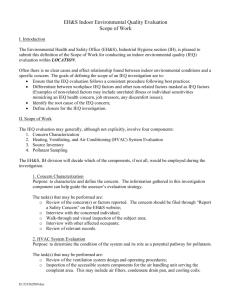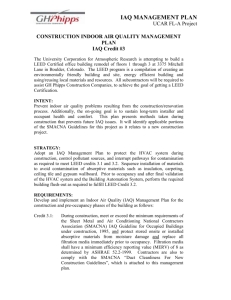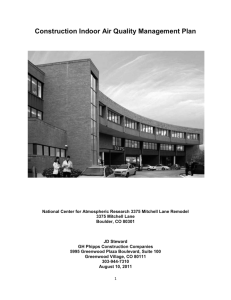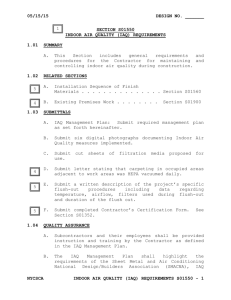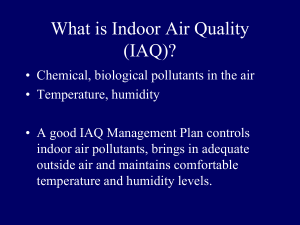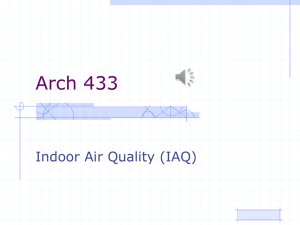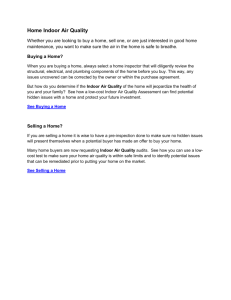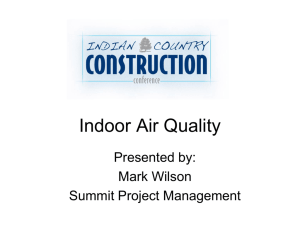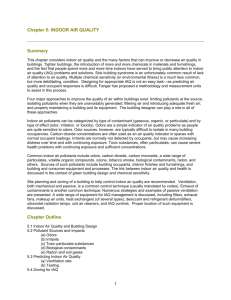Approved By: - Kennesaw State University
advertisement
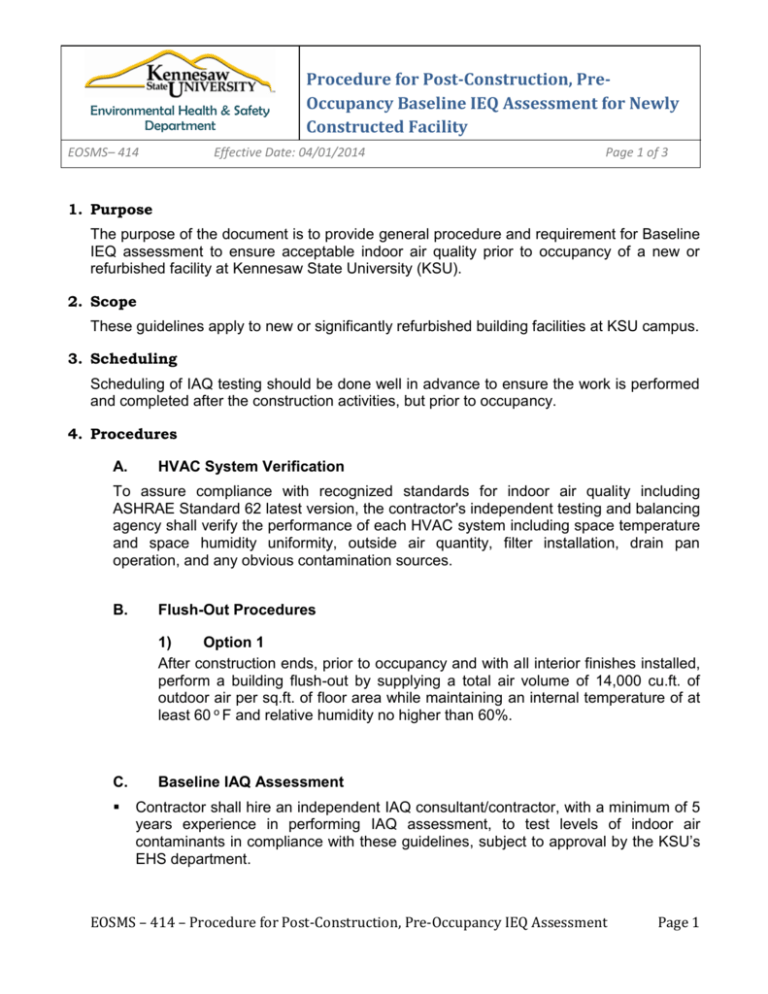
Environmental Health & Safety Department EOSMS– 414 Procedure for Post-Construction, PreOccupancy Baseline IEQ Assessment for Newly Constructed Facility Effective Date: 04/01/2014 Page 1 of 3 1. Purpose The purpose of the document is to provide general procedure and requirement for Baseline IEQ assessment to ensure acceptable indoor air quality prior to occupancy of a new or refurbished facility at Kennesaw State University (KSU). 2. Scope These guidelines apply to new or significantly refurbished building facilities at KSU campus. 3. Scheduling Scheduling of IAQ testing should be done well in advance to ensure the work is performed and completed after the construction activities, but prior to occupancy. 4. Procedures A. HVAC System Verification To assure compliance with recognized standards for indoor air quality including ASHRAE Standard 62 latest version, the contractor's independent testing and balancing agency shall verify the performance of each HVAC system including space temperature and space humidity uniformity, outside air quantity, filter installation, drain pan operation, and any obvious contamination sources. B. Flush-Out Procedures 1) Option 1 After construction ends, prior to occupancy and with all interior finishes installed, perform a building flush-out by supplying a total air volume of 14,000 cu.ft. of outdoor air per sq.ft. of floor area while maintaining an internal temperature of at least 60 o F and relative humidity no higher than 60%. C. Baseline IAQ Assessment Contractor shall hire an independent IAQ consultant/contractor, with a minimum of 5 years experience in performing IAQ assessment, to test levels of indoor air contaminants in compliance with these guidelines, subject to approval by the KSU’s EHS department. EOSMS – 414 – Procedure for Post-Construction, Pre-Occupancy IEQ Assessment Page 1 Department of Environmental Health & Safety EOSMS– 414 Procedure for Post-Construction, PreOccupancy Baseline IEQ Assessment for Newly Constructed Facility Effective Date: 04/01/2014 Page 2 of 3 IAQ testing shall be performed following the completion of all interior construction activities and prior to occupancy. The building shall have all interior finishes installed including, but not limited to, millwork, doors, paint, carpet, and acoustic tiles. Perform testing prior to installation of furniture, workstation components, and casework. IAQ testing shall be conducted using testing protocols consistent with the EPA’s Compendium of Methods for the Determination of Air Pollutants in Indoor Air. The independent IAQ contractor shall prepare a sampling plan for the approval of by KSU EHS Department. The plan shall specify sampling locations, instrumentation, sampling methods and quality control procedures. 1) Sampling Procedure 1. Air samples shall be collected during normal occupied hours (prior to occupancy) with the building ventilation system starting at the daily normal start times and operated at the minimum outside air flow rate for the occupied mode throughout the duration of the air testing. 2. IAQ samples shall be taken for each portion of the building served by a separate ventilation system. 3. The number of sampling points shall not be less than one per 25,000 sq. ft., or for each contiguous floor area, whichever is larger. Verify areas to be tested with the KSU’s representative. 4. Samples shall be collected within the breathing zone, between 3’–0” and 6’–0” above the finished floor and over a minimum 4-hour period. 5. For formaldehyde and TVOC, at least one outdoor air samples, for each contaminant, shall be collected simultaneously with indoor sampling at appropriate outside locations for comparison. EOSMS – 414 – Procedure for Post-Construction, Pre-Occupancy IEQ Assessment Page 2 Department of Environmental Health & Safety EOSMS– 414 Effective Date: 04/01/2014 2) D. Procedure for Post-Construction, PreOccupancy Baseline IEQ Assessment for Newly Constructed Facility Page 3 of 3 Evaluation Criteria Maximum concentrations for monitored IAQ pollutants shall not exceed the limits listed in the most current LEED standard. Contaminant Formaldehyde Maximum Concentration 27 ppb Particulates (PM10) 50 µg m-3 total volatile organic compounds (tvoCs) 500 µg m-3 4-Phenylcyclohexene (4-PCH) 6.5 µg m-3 Carbon monoxide (Co) 9 ppm Reports and Submittals IAQ consultant shall prepare assessment reports showing the results and location of each test, a summary of the HVAC operating conditions, and a listing of any discrepancies and recommendations for corrective actions, if required. In the event that any non-compliant test results occur, Contractor must provide a written report to KSU describing the source(s) of the non-compliant condition(s) and the corrective action(s) implemented. For each sampling point where the maximum concentration limits are exceeded, the Contractor is responsible for conducting additional flush-out with outside air and retesting the specific parameter(s) exceeded to indicate the requirements are achieved. EOSMS – 414 – Procedure for Post-Construction, Pre-Occupancy IEQ Assessment Page 3
